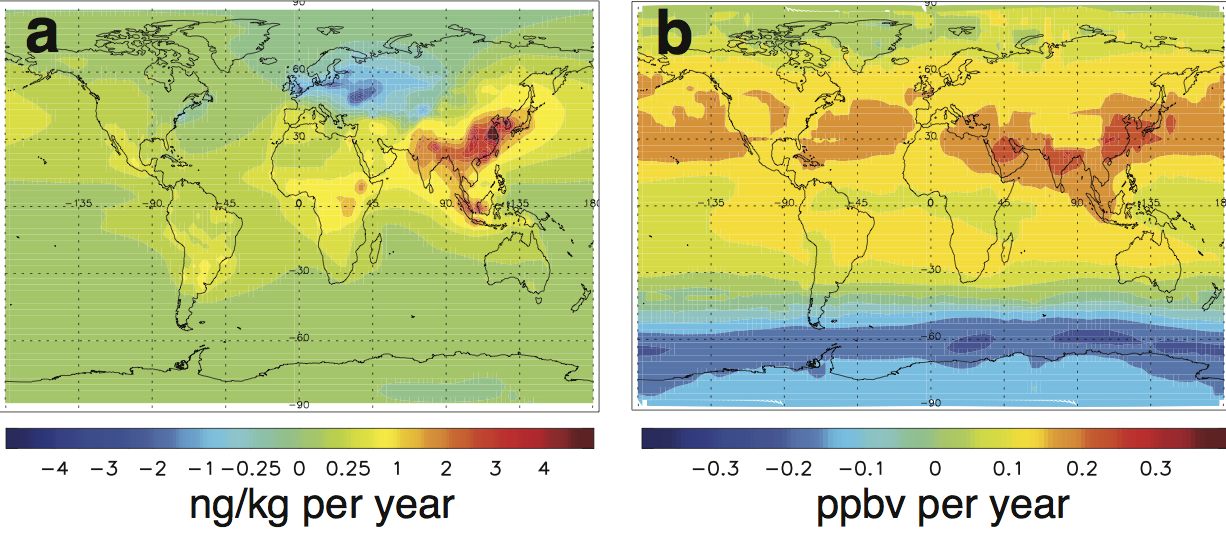
The northern tropics are on a march toward the pole. Over the last thirty years, the warm, moist belt around the equator has expanded by between 2-and-8 degrees northward.
When the phenomenon was first described five years ago, it was thought to be fueled primarily by carbon dioxide emissions. But a report, published recently by University of California at Riverside researchers in the journal Nature, has proposed a new driver of the expanding tropics: soot and ozone pollution generated largely by wood burning and diesel combustion in the rapidly developing nations of Southeast Asia.
Of particular concern for residents of California and other arid regions of the West is that the growth of the tropical belt may be forcing storm tracks farther north, in turn, causing the margins of the world’s subtropical deserts — including those of the American Southwest — to advance northward as well.
According to Robert Allen, an earth science professor at UC Riverside and lead author of the report, the study examined the effect of two short-lived atmospheric pollutants: black carbon, the soot seen emanating from diesel exhaust pipes or household chimneys; and tropospheric ozone, a product formed when carbon monoxide and nitrogen oxides react with organic compounds in the presence of sunlight.
Both are easily recognized when they are lingering in a “brown cloud” above a large city, but it turns out that smog also plays an important role in the dynamics of the global climate. “The prevailing theory was that this expansion of the tropics was due to greenhouse gases and a more uniform warming,” Allen told me.
While the bulk of the world’s black carbon comes from the burning of forests and grasslands, the greatest anthropogenic sources are the burning of wood and animal dung for cooking and heating homes and the combustion of diesel engines. Pound-for-pound, so to speak, black carbon is far more potent than CO2 in terms of its warming effects on the atmosphere.
Something in the air: a. shows concentration of black carbon emissions; b, shows concentration of ozone. Red indicates levels of higher emissions.
Previous computer models, which only considered carbon dioxide “forcing,” showed about 11% of the observed expansion. By adding black carbon and tropospheric ozone into the equation, Allen says his team’s model revealed nearly half the expansion observed in nature. “It may be that the amount of emissions is being underestimated, and therefore so are the trends.”
A local consequence here in the western U.S. is that tropical expansion seems to be influencing precipitation patterns, pushing storm tracks farther north. “For example, the southern portions of the United States may get drier if the storm systems move further north than they were 30 years ago,” said Allen in a UC Riverside press release. “Indeed, some climate models have been showing a steady drying of the subtropics, accompanied by an increase in precipitation in higher mid-latitudes.”
If the pattern holds, in the not too distant future, cities at the northern margins of subtropical deserts could find themselves thrust into full-fledged deserts, says Allen – with one caveat, that is. “There is no way to know if the current emission levels will hold,” he said. If China, India and other large emitters can substantially cut back on the black carbon and tropospheric ozone being put into the air, the effect could be mitigated rapidly. This is because unlike carbon dioxide, which remains in the atmosphere for centuries after it is emitted, these pollutants have short “residence” times in the atmosphere.
The tropics of the Southern Hemisphere are also expanding. But unlike the expansion of the northern tropics, that process has been largely attributed to the depletion of the stratospheric ozone layer along with greenhouse gas emissions.

